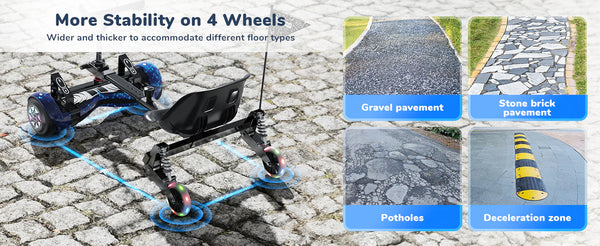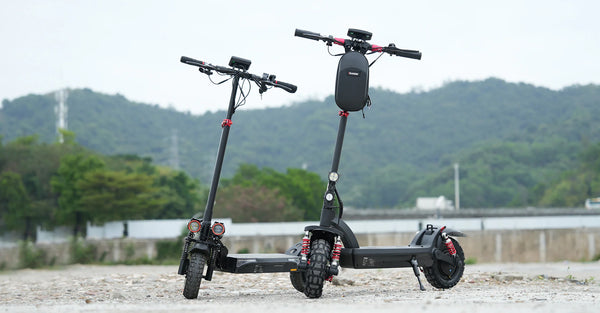
Are Hoverboards Eco-Friendly?
Hoverboards have surged in popularity in recent years, not just as a fun toy but as an innovative mode of transportation. As more people seek greener alternatives, one question comes up frequently:
🤔Are hoverboards eco-friendly?
In a world where electric vehicles are taking center stage, people are keen to know if their favorite gadget is a friend of the planet or just another energy guzzler. Let’s roll into the environmental impact of hoverboards and discover what makes for a true green ride.
What Makes a Hoverboard Eco-Friendly?
The concept of an eco-friendly hoverboard revolves around several key factors. In essence, a hoverboard can be deemed eco-friendly if it has a minimal negative impact on the environment throughout its lifecycle from production to end-of-life disposal. Here are some aspects to consider:
- Energy Efficiency: Hoverboards run on rechargeable batteries, most commonly lithium-ion ones. While they don't guzzle gasoline, their energy efficiency varies. Look for models with motors designed to sip power gently rather than chug it like a late-night energy drink.
- Battery and Power Source: The battery is the heart of a hoverboard’s environmental impact. Choose long-lasting, durable batteries that won’t have you scrambling for a replacement every few months. Bonus points if your hoverboard comes with energy-saving features like auto-shutoff, so it’s not sucking up electricity while it’s parked.
- Materials and Production: Hoverboards made from sustainable or recyclable materials? Yes, please! Ideally, the less plastic, the better. Keep an eye out for models that avoid heavy metals or chemicals that are bad news for the environment.
- Lifespan and Durability: Ever heard the phrase "buy it for life"? A hoverboard built to last means fewer thrown-away gadgets and less e-waste. Sturdy construction and high-quality parts are key.
Environmental Benefits of an Eco-Friendly Hoverboard
Hoverboards offer several advantages when compared to traditional modes of transportation like cars or motorcycles. While their impact is not entirely negligible, an eco-friendly hoverboard can be a viable choice for reducing carbon footprints in specific scenarios. Here are some benefits:
✅Reduction in Greenhouse Gas Emissions
One of the biggest benefits of choosing a green ride like an electric hoverboard is the potential reduction in greenhouse gas emissions. They might not have the muscle to replace your car for long trips, but hoverboards don’t emit harmful pollutants, making them a cleaner choice for short-distance travel - or just being fun!
✅Lower Energy Consumption
Hoverboards are lightweights — in a good way! They don’t need the power of bulkier electric vehicles like e-scooters or e-bikes, so they naturally consume less energy. That means less strain on the planet and your wallet.
✅Encourages Green Transportation
Taking a quick trip to the store? Hop on your hoverboard instead of starting up the car. Those short car rides can be surprisingly fuel-inefficient, so swapping them out for a green ride cuts down on emissions.
✅Promotes a Sustainable Lifestyle
The hoverboard trend has sparked interest in other eco-friendly personal transport options. This wave of interest in clean commuting is helping push the movement toward more sustainable living. So, go ahead, lead the charge!
The Environmental Drawbacks of Hoverboards
Despite their benefits, hoverboards also have certain environmental drawbacks that need to be addressed for them to become a truly eco-friendly option. These include:
⚠️Battery Production and Disposal
The production and disposal of lithium-ion batteries pose significant environmental challenges. Mining the raw materials for these batteries, such as lithium, cobalt, and nickel — not exactly a clean process, can result in habitat destruction, soil degradation, and water pollution. Moreover, improper disposal of batteries can lead to toxic chemical leakage, harming the environment and local communities.
⚠️Short Product Lifespan
Some hoverboards are made with low-quality materials, leading to a short lifespan. When these devices break down, they often end up in landfills, contributing to e-waste. Ensuring a longer product life is crucial for any eco-friendly hoverboard to reduce its overall impact.
⚠️High Energy Demand for Manufacturing
Manufacturing hoverboards can be energy-intensive, with high carbon emissions associated with the production of electronic components. This makes it essential for companies to adopt more sustainable manufacturing practices to create a true green ride.
Choosing a Hoverboard Based on Environmental Certifications
When searching for an eco-friendly hoverboard, it’s important to look for specific certifications that signify a commitment to sustainable practices. These certifications provide assurance that the manufacturer adheres to environmentally sound production processes and prioritizes sustainability. While some of these certifications are more common in electronics and transportation industries, they are starting to appear in the personal transportation space as well. Here are a few key certifications to consider:
📝UL2272 Certification
UL2272 is a safety certification specifically designed for hoverboards, focusing on the electrical systems that power the device. This standard, set by Underwriters Laboratories (UL), ensures that hoverboards meet rigorous safety guidelines, particularly for the battery, charger, and electrical drive system, reducing the risk of fire and overheating.

Hoverboards with UL2272 certification have passed comprehensive testing, offering peace of mind for consumers by ensuring safer operation and better protection against electrical hazards. When shopping for a hoverboard, looking for the UL2272 label is a smart move to prioritize safety.
📝ISO 14001 Environmental Management Standard
This certification is granted to companies that implement effective environmental management systems, reducing their environmental impact across operations. Hoverboards with this certification are more likely to use eco-friendly materials, produce less waste, and prioritize energy efficiency.
📝RoHS Compliance
The Restriction of Hazardous Substances (RoHS) certification ensures that electronic products are manufactured without certain hazardous materials like lead, mercury, and cadmium. If a hoverboard is RoHS compliant, it’s a safer, more eco-friendly choice that minimizes harmful chemical use.
What to Look for in an Eco-Friendly Hoverboard
To find the best eco-friendly hoverboard, consider the following features and certifications:
- Energy Efficiency Rating: Look for hoverboards that are marked with energy-efficient certifications, which indicate they use power more judiciously.
- Sustainable Materials: Opt for hoverboards made from recycled or sustainable materials. Avoid products that use a lot of plastic or have non-recyclable components.
- Battery Longevity: Choose a hoverboard with a high-quality battery that offers a long life cycle and supports eco-friendly disposal or recycling programs.
- Repairability: Some brands offer parts that are easy to replace or repair, which extends the lifespan of the hoverboard. A truly green ride is one that can be easily fixed instead of being discarded.
- Environmental Certifications: Consider hoverboards from companies that prioritize sustainability and have certifications such as ISO 14001, which indicates that the manufacturer follows international environmental management standards.
How to Make Your Hoverboard More Eco-Friendly
Even if your hoverboard isn’t marketed as an eco-friendly option, there are still steps you can take to minimize its environmental impact:
- Maintain Proper Care: Regular maintenance can extend the lifespan of the device, reducing the need for early replacements.
- Eco-Friendly Charging Practices: Avoid overcharging, as this shortens the battery life and leads to unnecessary power consumption. Use smart chargers that automatically turn off when the battery is full.
- Recycle Responsibly: When it’s time to replace the battery or the entire device, look for e-waste recycling centers that handle electronic devices responsibly.
- Opt for Renewable Energy: If possible, charge your hoverboard using renewable energy sources like solar power to further reduce its carbon footprint.
Green Alternatives to Hoverboards
While hoverboards can be a good eco-friendly option in some cases, there are other green alternatives that might be even more sustainable:
1. Electric Scooters🛴
Electric scooters are a popular alternative with a similar function but often with higher energy efficiency. Many models offer a longer battery life and better durability, making them a more eco-friendly option.
2. Electric Bicycles🚲
Electric bicycles provide a more versatile mode of transport and are more suitable for longer distances. They generally have a lower environmental impact due to their larger battery capacity and more efficient use of energy.
3. Skateboards and Longboards🛹
For those looking for a green ride with minimal environmental impact, traditional skateboards or longboards are excellent options. They have no emissions, don’t require batteries, and can last for years with proper care.
Final Verdict: Are Hoverboards Truly Eco-Friendly?
So, are hoverboards eco-friendly? The short answer is… it depends. While they offer lower emissions and energy consumption compared to traditional vehicles, their environmental impact can vary based on factors like materials, battery life, and manufacturing practices.
By choosing a high-quality, durable hoverboard, maintaining it well, and keeping an eye on eco-certifications, you can enjoy the ride while keeping your environmental impact in check. And with advances in battery tech and sustainable manufacturing on the horizon, the future of hoverboards is looking greener than ever.
So, jump on and ride the wave of the future — just remember to keep it green!
Product Category
Recent Posts

Up to 50% Off! Our Black Friday 2024 Event Is HERE!

Best Hoverboard with Seat: K3 Hoverboard Go-Kart Guide!

Go-Kart: The Complete Guide to Hoverboard with Seat

Electric Scooter Wheels: Solid Tires vs Pneumatic Tires





















































Still, need help? Contact Us: support@ihoverboard.com
What's the option? Check out the option now!
Leave us a message